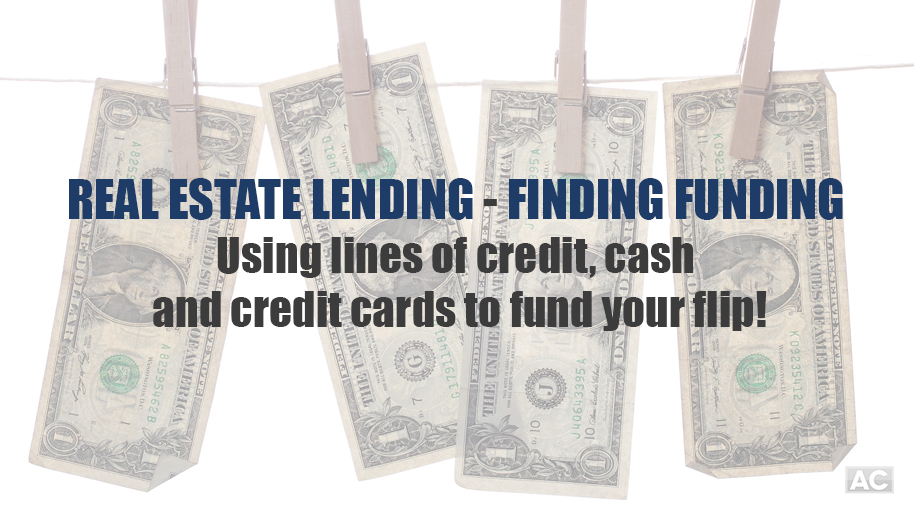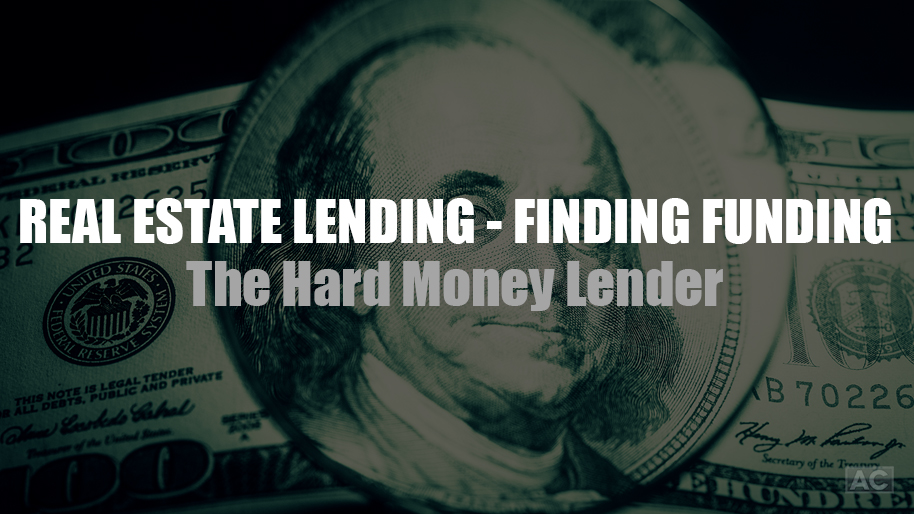Blog
Real Estate Lending: Finding Funding – Using Lines of Credit, Cash, and Credit Cards to Fund Your Flip!
October 25, 2014Last time, we discussed HML’s or “hard money lenders” and how they work. Today, I want to go over another source of lending. Lines of credit, business lines of credit, credit cards, and cash. This is borrowing money on a line of credit or on a low-interest credit card. Cash is obviously your best and safest funding option. The “rub?”. You have to have access to a large amount of cash! Most investors don’t have large quantities of liquid capital available, especially new investors. Cash is indeed “king” and if you have it, you’ll likely get a much better deal from your seller. However, in my experience, many of those who have the cash on-hand do not want to put it all out there on the line, they’d rather leverage it for multiple concurrent deals. Credit cards are often never even considered by investors. However, I know of several investors who have bought and rehabbed many investments using only a credit card. This is an especially good option when the credit card being used has super-low or no interest rates. I mean, that’s basically free money! Using a credit card is a funding option that many investors who have great credit miss out on. In fact, right now, one of my investor friends is doing a joint-venture (JV) deal with me and is using his credit card for the entire purchase. Quite literally, he has perfect credit and has 30-40 low or no-interest credit cards with very large limits. He built his credit up for years and once he decided to begin investing, his fiscal discipline paid off. Also, he literally can fund all of his own deals at almost no cost! Virtually everyone takes a credit card for payment these days. All it takes is an iPad and a square machine. Heck, with the right equipment, a vendor can slide it right through their smartphone on the spot! There’s also ways that you can get cash out of your credit card account. You can set-up whats called a Merchant Account which gives you the option to pull cash from their credit card and deposit it into their Merchant Account, which will then be paid out in cash. This links your credit card with you Merchant Bank account. Merchant Accounts are quite popular. Some examples are Amazon, Ebay, Paypal, etc. And for those who have some dings on their credit, there are companies out there that specialize in helping you build and repair your credit. Once they repair your credit, they will help point you in the right directions for lenders with better limits and interest rates. These entities will basically build or repair your credit. Now, let’s talk about LOC’s, or “Lines of Credit.” A line of credit is an amount of credit extended to a borrower by a bank or other financial institution. It is effectively a source of funds that can readily be tapped at the borrower’s discretion. Interest is paid only on money actually withdrawn, however, the borrower may be required to pay an unused line fee – an annualized percentage fee on the money not withdrawn. Lines of credit can be secured by collateral, or may be unsecured. There are basically three types of LOC’s: HELOC – Home...
read moreReal Estate Lending: Finding Funding – The Hard Money Lender
October 25, 2014During the series introduction, I listed five funding sources for every investor. In the introduction, I merely skimmed over the five funding options. However, we’ll be discussing each funding option in more detail, beginning today with “HML” or Hard Money Lending. A hard money lender is a very easy route for investors. Why? Because HML’s are in the business to loan YOU money! It’s how they make money. As I mentioned previously, any investor worth his salt uses or at a minimum, has access to all five lending sources that I listed in the series introduction. In my opinion, HML’s are the easiest way to access funding. This is especially important for inexperienced investors. These beginner investors have a tendency to become obsessed with finding the cheapest “private” money, meanwhile, there’s an HML right up the road who is in-business to loan you money! Sure, maybe his terms are not exactly what you want but remember, don’t step over a dollar to save a dime! Hard money doesn’t necessarily have to be your only source for funding but it should take priority as the easiest way to get funding for your first flip. I just so happen to be in the middle of several large flips. I am currently closing on a home with a $500,000 purchase price. Yes, my other flips use other sources of funding, but for this one, I needed a hard money lender because of the price. I am in no-way a beginner investor as I’ve spent over a decade in the industry – but I still use hard money lenders for certain situations. Especially situations in which the purchase price is a little higher and I need guaranteed approval. How does a hard money loan work? An HML loans you funds to both purchase and rehab your investment. In most HML cases, one has to come to closing with roughly 10-20% down depending on the lender. HML’s will give you the option of a six or twelve month plan. I recommend a twelve month plan. Six months can work if everything goes perfectly. But if things don’t go as planned and the home doesn’t sell, the HML can foreclose or charge additional points or interest. HML’s make their money by charging you points/interest. One point equals 1% of the total loan. Interest will generally be anywhere between 12-18%. HML’s typically do not charge a pre-payment penalty so one can pay off the loan amount at any time without being charged additional monies. One will usually receive the rehabbing construction funds in several draws. These draws can be set-up in many different ways. For example, let’s say we have a $30,000 rehab project. In this case, one would typically set-up three separate $10,000 draws. You would then proceed to complete $10,000 worth of work and then would request another draw for $10,000. The lender will then send an inspector to your flip. As long as the work is completed, the lender will release the next $10,000. Once you prove yourself, HML’s will likely be wiling to do multiple deals with you at the same time. You just need to prove yourself. Will this option cost you more money? Yes, but it’s paramount that you...
read moreReal Estate Lending: Finding Funding – Introduction
October 25, 2014As we’ve discussed previously, the number one problem for the majority of new investors is that they are unable to find their first deal. The second biggest problem for new investors, or occasionally experienced investors, is finding the funding for your deal. However, my decade-plus worth of experience has showed me that these problems are more or less excuses! One must first understand and be aware of the different types of lending when it comes to real estate investing, rehabbing, or flipping. I will list them below and we will expound on them much more in the very near future. Here are the types of lenders: 1. Hard money lender – aka “HML,” this is an easier route as they’re in the business to loan you money. 2. Private lender – obviously “private lenders” can lend you money but is not considered an “institutionalized” lender. These usually come from immediate circles of influence such as a doctor, attorney, church member, friend, or family member. 3. Lines of credit/cash – aka “LOC, Business LOC, or credit cards”. This is borrowing money on a line of credit or a credit card. I know of several investors who have bought and rehabbed investments using only a credit card. Especially with low or no interest rates. Cash, this is obvious. If you have the cash, you’ve got the house. 4. Self-directed IRA/401K – this is using one’s 401k or IRA money or using someone else’s 401k or IRA to loan you capital 5. Joint Venture or JV – finding an investor who will put up 100% of the money for the purchase and rehab and then split the profit on the backend. This is a very popular source of funding As I mentioned earlier, we will expound on each of these in future blog articles. We’ll talk about how they work and how investors use this type of funding. Usually, investors don’t only use one source of funding. They use multiple sources of capital. In my opinion, the most successful way to use lenders is to utilize all avenues of funding! When it comes to accessing capital for your rehab, you don’t need to have liquid cash in your bank account. You just need access to someone who has funding available. Don’t sit around and wait for all of the money to be into deposited into your account in order to buy a house. I simply grab my Rolodex and call my lenders directly. A lot of investors both teach and state, “find the house and the money will find you“. There is an element of truth to that statement but the market is always tough and depending on the area, the inventory might be low. This is why the investors who already have access to funding are usually far more successful. The capital is already there so you can focus on finding the right deal. I always recommend gutting your funding squared-away first. You have to be a confident player to make it in this business so line up your money first and then start looking for your deals. ...
read moreHow to Invest in Real Estate: Standing Out from the Competition with Your Brand – Ann Lee Interiors
October 25, 2014When teaching our students how to invest in real estate, one focus is our brand. When Ann Lee was founded, as with any new business, there was a multitude of decisions we had to make. But one thing was crystal clear. We wanted our buyers to have a different experience. We wanted to set ourselves apart in the marketplace. Because frankly, the majority of flippers were all beginning to look the same. It was getting extremely boring to be a flipper and have your product stand out. But we changed that quickly! So we created a brand called “Ann Lee Interiors”. We built our own army of dedicated agents, lenders, contractors and employees who follow and promote our brand. As soon as a potential buyers walks through the front door, we wanted to give them a unique buying experience! We take our buyers on their own custom journey. And during that journey, every single small detail is important. It’s the little things that make a difference. Things like custom Ann Lee labeled house keys, custom brand postcards, and small customized pop-up promotional cards spread throughout the home. When you’ve built your brand, you’re in-turn, customizing every single flip! When you customize the home and the home-buying experience, you have just ensured that your potential buyers feel special. Your product, in turn, stands out from your competitors. You may ask, “what sets Ann Lee Custom Homes apart from their competitors? Most real estate investors would never share their secrets with the public, but we’re different! We want to share our wealth of knowledge to help make you more successful and profitable. While I do not wish to bog you down with details right now, there are 5 simple ways to ensure that your house stands-out: Be different from your competitors – It’s not rocket science! Every buyer has an mental picture and checklist of exactly the type of house that they want. Make your investment stand-out by giving the potential buyer what they want instead of what you want or is the least expensive. It needs to look like a custom designed home rather than a home designed by a contractor or narrow-minded investor! Be aware of how the potential buyer perceives you – Our buyers perceive us as custom home designers rather than flippers/investors wanting to earn a quick buck and move onto the next investment without putting any thought or pride into their flip. Our buyers see our homes as ones that they are eager and excited to purchase rather than a house that they are just “agreeing” to buy.So again, ask yourself this: “How does my potential customer perceive me? Do they perceive me as a ‘flipper’ or as a ‘custom home designer’?” Tile is “art” not “flooring” Most investors consider tile or laminate floors simply as “flooring.” We’re different – we consider them to be a form of “art!” I want the potential buyer to feel like they walked into a 5-star hotel and not $120,000 house! I can do that easily by using a specialty tile that doesn’t cost that much more than that basic beige 12×12. When you start to think of it as “art” rather than “flooring,” your potential buyers will begin to think the same way…and...
read moreFlipping Houses: Strategy vs Tactic Part 1
October 24, 2014As I travel across the country educating investors on flipping houses and how to make money in real estate. I am often asked “What is the one thing that separates the successful investor from the struggling investor?”. There are several things that I believe separates successful investors and struggling investors. The first thing that comes to mind when flipping houses is strategy versus tactics. I tell my students that one must understand their strategy before they initiate their tactics. In today’s modern digital age, many young or inexperienced entrepreneurs see a cable show, read a blog article, or even attend one of those real estate “guru” events and get the “itch” to give real estate investing a try. At the “guru” seminar, they’ll hear some slick shark salesman give them a preview of some new, hidden, secret tactic in real estate that will make them a million dollars overnight. It could be buy/fix/sell, lease options, notes, short sales, or multi-family…but they get excited and want to stop everything, run out and try this new real estate investing “tactic.” Just like life for the rest of us, this excited new investor eventually falls on hard times. They come across problems, something goes wrong and then they’re out of the real estate game just as quickly as they jumped in! Then they go back to whatever it was they were doing previously. This struggling entrepreneur and the person that jumps in and out of real estate does so because they lack the understanding of what they are actually trying to accomplish in real estate! They do not understand the strategy! One must be able to say, “Financially, this is where I’m at; over there – wherever that is for you – that’s where I want to end up. That’s my end-goal. I’m going to use real estate as the vehicle to get me where I want to go. Real estate will not be my life. It will not be who I am.” To personalize this, let me say it this way: real estate does not define me. But I’ve used real estate as a vehicle to take me from my parents basement during the market crash to being a successful investor and finally, financially free today. My very first goal in real estate was to make enough money/cash flow from rental properties to pay all of my normal monthly bills. At that time, I needed about $4,500 every month. Once I reached that $4,500 mark, I had arrived at my destination, my goal line. However, accomplishing my goal was much easier than I had thought it would be. So now, I wanted $10,000 per month. Once I reached that destination it was, “How about $15,000 per month?” Strategy will change and grow as we reach our destinations. There are two main points one must understand to make it in real estate: First, focus on your strategy, which is knowing where you are and where you want to be. That’s the path that you are going to go down; your game plan; your road map to change your financial destination. You’re going to follow this strategy. You will use real estate as your vehicle to get there. Now that you know your strategy, the next...
read more

































